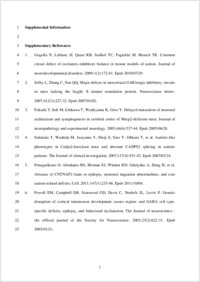Lack of parvalbumin in mice leads to behavioral deficits relevant to all human autism core symptoms and related neural morphofunctional abnormalities
- Wöhr, M. Department of Behavioral Neuroscience, Faculty of Psychology, Philipps-University of Marburg, Germany -
- Orduz, D. Laboratory of Neurophysiology, ULB Neuroscience Institute (UNI), Université Libre de Bruxelles (ULB), Belgium -
- Gregory, Patrick Anatomy Unit, Department of Medicine, University of Fribourg, Switzerland
- Moreno, Herman Department of Neurology, SUNY Downstate Medical Center, Brooklyn, NY, USA
- Khan, U. Department of Neurology, SUNY Downstate Medical Center, Brooklyn, NY, USA
- Vörckel, K. J. Department of Behavioral Neuroscience, Faculty of Psychology, Philipps-University of Marburg, Germany
- Wolfer, D. P. Institute of Anatomy, Faculty of Medicine, University of Zürich, Zürich, Switzerland - Institute of Human Movement Sciences and Sport, ETH Zürich, D-HEST, Zürich, Switzerland
- Welzl, H. Institute of Anatomy, Faculty of Medicine, University of Zürich, Zürich, Switzerland
- Gall, D. Laboratory of Neurophysiology, ULB Neuroscience Institute (UNI), Université Libre de Bruxelles (ULB), Belgium
- Schiffmann, S. N. Laboratory of Neurophysiology, ULB Neuroscience Institute (UNI), Université Libre de Bruxelles (ULB), Belgium
- Schwaller, Beat Anatomy Unit, Department of Medicine, University of Fribourg, Switzerland
-
10.03.2015
Published in:
- Translational Psychiatry. - 2015, vol. 5, no. 3, p. e525
English
Gene mutations and gene copy number variants are associated with autism spectrum disorders (ASDs). Affected gene products are often part of signaling networks implicated in synapse formation and/or function leading to alterations in the excitation/inhibition (E/I) balance. Although the network of parvalbumin (PV)-expressing interneurons has gained particular attention in ASD, little is known on PV’s putative role with respect to ASD. Genetic mouse models represent powerful translational tools for studying the role of genetic and neurobiological factors underlying ASD. Here, we report that PV knockout mice (PV−/−) display behavioral phenotypes with relevance to all three core symptoms present in human ASD patients: abnormal reciprocal social interactions, impairments in communication and repetitive and stereotyped patterns of behavior. PV-depleted mice also showed several signs of ASD-associated comorbidities, such as reduced pain sensitivity and startle responses yet increased seizure susceptibility, whereas no evidence for behavioral phenotypes with relevance to anxiety, depression and schizophrenia was obtained. Reduced social interactions and communication were also observed in heterozygous (PV+/−) mice characterized by lower PV expression levels, indicating that merely a decrease in PV levels might be sufficient to elicit core ASD-like deficits. Structural magnetic resonance imaging measurements in PV−/− and PV+/− mice further revealed ASD-associated developmental neuroanatomical changes, including transient cortical hypertrophy and cerebellar hypoplasia. Electrophysiological experiments finally demonstrated that the E/I balance in these mice is altered by modification of both inhibitory and excitatory synaptic transmission. On the basis of the reported changes in PV expression patterns in several, mostly genetic rodent models of ASD, we propose that in these models downregulation of PV might represent one of the points of convergence, thus providing a common link between apparently unrelated ASD-associated synapse structure/function phenotypes.
- Faculty
- Faculté des sciences et de médecine
- Department
- Département de Médecine
- Language
-
- English
- Classification
- Biological sciences
- License
-
License undefined
- Identifiers
-
- RERO DOC 255684
- DOI 10.1038/tp.2015.19
- Persistent URL
- https://folia.unifr.ch/unifr/documents/304305
Other files
Statistics
Document views: 107
File downloads:
- pdf: 189
- Supplementary material: 141

